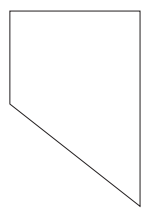Clusters should not be sorted from Major to Supporting and then taught in that order. To do so would strip the coherence of the mathematical ideas and miss the opportunity to enhance the major work of the grade with the supporting clusters.
- Assessment Limits :
s Items may not require students to name a given figure. Items may not require knowledge or use of ordered pairs or a defined coordinate grid system. Items may require students to draw a figure based on multiple attributes (e.g., an acute triangle), with the exception of right triangles. Items that include trapezoids must consider both the inclusive and exclusive definitions. Items may not use the term "kite" but may include the figure. - Calculator :
No
- Context :
Allowable
- Test Item #: Sample Item 1
- Question:
Which angle is acute?
- Difficulty: N/A
- Type: MC: Multiple Choice
- Test Item #: Sample Item 2
- Question: Fill in the circles to select all the attributes that apply to each set of lines.

- Difficulty: N/A
- Type: MI: Matching Item
- Test Item #: Sample Item 3
- Question: In social studies class, Armando learned about the state of Nevada. He
drew the picture shown to represent the shape of Nevada.

Which list below correctly describes the kinds of angles that appear to be inside the shape above?
- Difficulty: N/A
- Type: MC: Multiple Choice
Related Courses
Related Access Points
Related Resources
Formative Assessments
Lesson Plans
Original Student Tutorials
Teaching Ideas
Tutorials
MFAS Formative Assessments
Students are asked to identify right, acute, and obtuse angles in a two-dimensional figure, and explain the differences among these types of angles.
Students are asked to draw parallel lines, perpendicular lines, a point, and a line segment. Students also explain how a line segment is different from a ray or line.
Students locate points, lines, line segments, and rays in a given diagram.
Students are asked to identify parallel and perpendicular sides and explain how they know.
Original Student Tutorials Mathematics - Grades K-5
Classify and name angles in two-dimensional shapes to help a robot create a path using angles in this interactive tutorial.
Help a surfing crab learn how to find parallel and perpendicular sides in a variety of polygons as you complete this interactive tutorial!
Identify parallel lines and line segments, as well as perpendicular lines and line segments in two-dimensional figures by joining Parallel Man and Perpendicular Man as they help Mayor Mathematics save Mathopolis in this interactive tutorial.
Student Resources
Original Student Tutorials
Help a surfing crab learn how to find parallel and perpendicular sides in a variety of polygons as you complete this interactive tutorial!
Type: Original Student Tutorial
Classify and name angles in two-dimensional shapes to help a robot create a path using angles in this interactive tutorial.
Type: Original Student Tutorial
Identify parallel lines and line segments, as well as perpendicular lines and line segments in two-dimensional figures by joining Parallel Man and Perpendicular Man as they help Mayor Mathematics save Mathopolis in this interactive tutorial.
Type: Original Student Tutorial
Tutorials
This Khan Academy tutorial video defines and illustrates parallel and perpendicular lines.
Type: Tutorial
This Khan Academy tutorial video identifies acute, right, and obtuse angles and justifies each identification.
Type: Tutorial
This video discusses the differences between lines, line segments and rays.
Type: Tutorial







